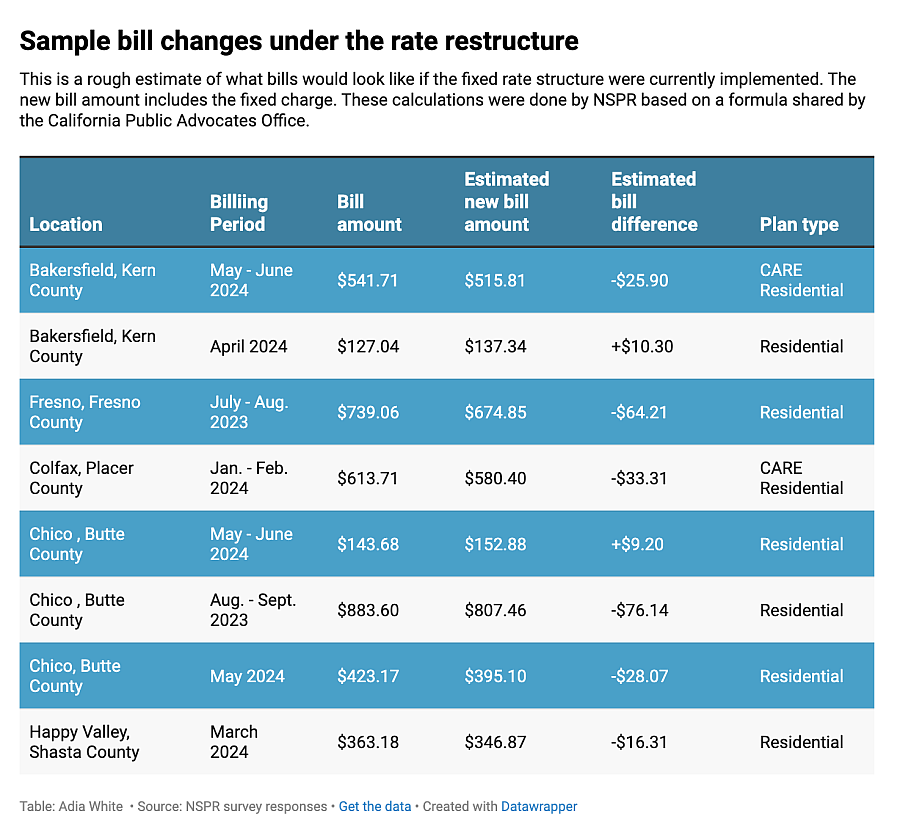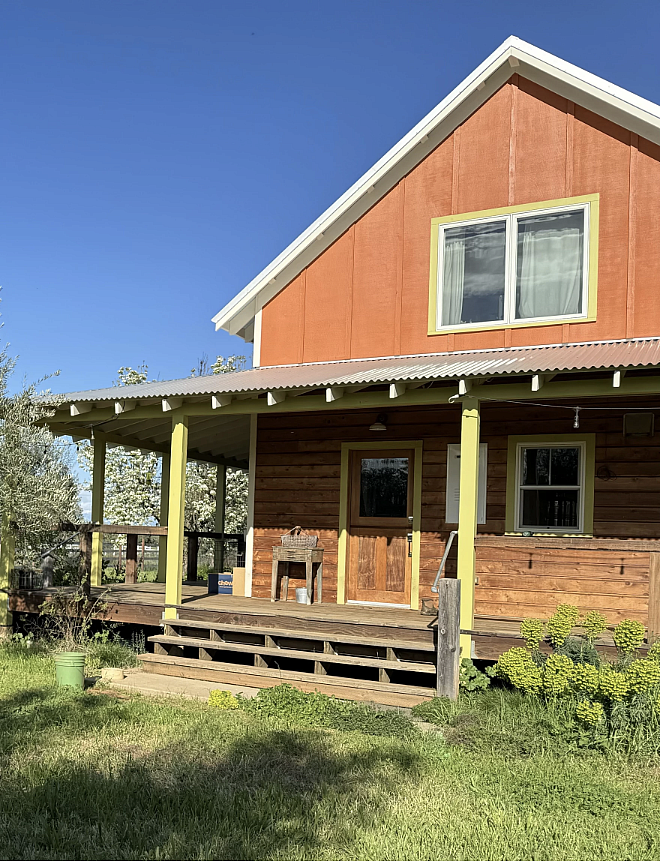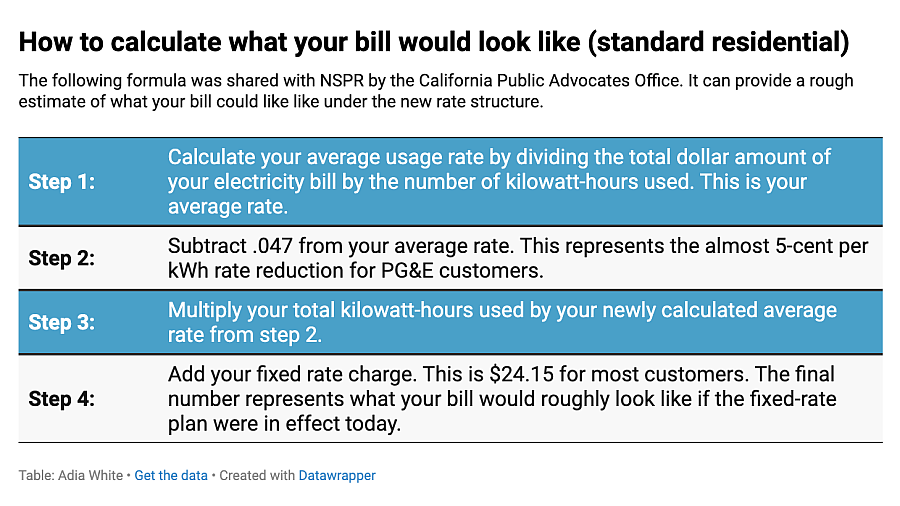Rare win for inland Californians in new utility bill structure
The story was originally published by North State Public Radio with support from our 2024 California Health Equity Impact Fund.

Elizabeth and Pedro Betancourt at their farm in Happy Valley, California on April 5, 2024.
Adia White/NSPR
Pedro and Elizabeth Betancourt try to do as much as they can to conserve their energy use. Their home is under 1,200 square feet. They designed it to be energy efficient, with insulated walls that are six inches thick instead of the standard four. They swapped out their old appliances and unplug their electronics when they’re not in use. Despite this, they used around 860 kilowatt-hours of electricity during their billing cycle from February to March this year — amounting to a $363.18 Pacific Gas and Electric (PG&E) electricity bill. Their use also includes charging an electric car.
Elizabeth Betancourt said they have made adjustments to absorb the higher bills. The couple lives in Happy Valley in the Northern Sacramento Valley. They run a small farm, which partners with a local community college to grow produce for the student food pantry. They had a cold storage room built, but haven’t started using it yet because cooling it to the required temperature is too expensive.
Still, she said they feel fortunate they’ve been able to afford the higher bills.
“It is extremely expensive, but we can usually pay it every month,” she said. “We have a significant number of people that we know who would not be able to pay a bill like this.”
A new rate structure would benefit similar families
A rate restructure, approved by the California Public Utilities Commission (CPUC) in May, is designed to benefit people like the Betancourts who live in regions of the state that see more extreme temperatures. Cooling over the summer requires a lot of electricity. Temperatures in Redding, the closest city to where they live, average in the high 90s during the summer but can surpass 110 degrees Fahrenheit. Redding reached a record-breaking high over this weekend of 119 degrees.
Right now, grid maintenance costs are generally lumped into the overall price of electricity, which means those who use more pay more to support the infrastructure.
The recent decision by the CPUC will change that. Starting by late 2025 or early 2026, investor-owned utility companies, like PG&E and Southern California Edison, will start adding a fixed charge of $24.15 per month for the costs of maintaining the grid. The charge will be between $6-12 a month for those on low-income plans such as CARE or FERA. At the same time, the overall price of electricity would be reduced by around 5 cents per kilowatt-hour for the average customer. For many, the rate reduction will offset the monthly charge.
One of the goals is to make costs more equitable for people like the Betancourts, who use more electricity because of where they live. Energy regulators also hope it will make it more affordable for people to purchase electric vehicles or swap out gas appliances for electric ones, helping the state meet its goal of reducing carbon emissions.

Who pays more and who saves under the new plan
Residents who live in more temperate regions of the state and aren’t on low-income plans may see their bills increase. That’s because the reduction in overall electricity cost won’t make enough of a difference to counteract the fixed charge for very low-energy users.
North State Public Radio looked at a dozen bills from those who live in the Sacramento and Central Valley and found most customers who shared their bill would save under the new billing structure during hot summer months. Spring and winter bills were mixed, with some seeing slight savings and others seeing slight increases. Representatives from the California Public Advocates Office shared a formula to do a rough estimate of what a customer’s bill would look like if the fixed charge were implemented today.

The Betancourts' home in Happy Valley, California, on April 4, 2024.
Adia White/NSPR
Using that calculation, NSPR estimated the Betancourts would have saved roughly $16 from their $363 February bill.
“I'm surprised by that outcome, frankly, but pleased,” Betancourt wrote in an email. “I hope the different billing practice results in even more savings for those at lower economic/income levels.”
In the North State — Chico non-profit pays a nearly $900 summer bill
Paths Straight to Recovery in Chico has a home with eight beds for men recovering from addiction. The Christian recovery home also offers a number of programs and meetings to help residents stay sober. Treasurer Katya Yarosevich said the organization is able to sustain itself through donations, but rising energy costs make it hard to predict the budget.
“Donations being what they are, you never know when they're going to come in and when they will not,” she said “So it does provide some tension not knowing exactly where we're gonna be with those bills, especially in the summertime.”
Last summer, she said the organization paid $883.60 for their PG&E electricity bill for a billing period that covered the second half of August and the first week of September. This summer, cooling costs will be higher after PG&E raised its rates at the beginning of the year.
“If it gets to the point where we have too much going out to those bills, then that is going to limit how many people we can offer support to, for meetings and so forth.”
Had the new rate restructure been in effect at the time, Paths Straight to Recovery would have saved roughly $76 from their $883.60 bill.

The Paths Straight to Recovery Home in Chico, California. Photo courtesy of Katya Yarosevich.
Adia White/NSPR
In the Central Valley — A $412 summer bill
Much like the Betancourts, Bakersfield resident Amber Lasarev has put effort into reducing her utility bills. She and her husband put magnetic strips under their door to seal off excess air from outside. They also closed off one of the rooms in their three-bedroom house by shutting the vent and sealing the space under the door. They keep their curtains drawn to keep the home cooler. Still, she spent $412 for a billing period that spanned the end of August and the beginning of September. She said they’ve always been able to afford their bill, but the rising costs have still affected their lives.
“We're not missing meals or anything,” she said. “But it's kind of like, well, we could probably skip the night out knowing that we've got a huge bill coming because of the heat wave … things like that are pretty common for us.”
Under the new rate structure, she would have saved roughly $24 from her August-September bill, which was $412. However, she would pay more in the spring. During her April billing period, she would have paid roughly $9 more on her $127 bill.
Who spends the most on their energy?
Mike Campbell, assistant deputy director of energy with the California Public Advocates Office, said there are many reasons why some households use more energy than others. This can include the number of people who live there, the age of the home and whether people rent or own.
“It is not that customers with higher usage are worthy of scorn, or are somehow energy hogs, or wasteful. Those people do exist. But by and large, rates are so high [that] people are doing everything they can to conserve,” Campbell said. “So really what we're seeing is people facing really punitive charges. And so we're hoping that this implementation of a fixed charge will reduce the volatility in bills.”
In addition to paying more to cool their homes, residents in inland regions have some of the highest poverty rates in the state. In Kern County, more than 15% of the population is living below the poverty line, that’s compared with San Francisco and Alameda counties where around 5.5% of people live below the poverty line.
The new rate structure is intended to help redistribute power costs so vulnerable customers aren’t paying a disproportionate amount to maintain the grid.
Still, some are concerned that the fixed charge could become another mechanism for utility companies to raise bills.
When CPUC Commissioner Darcie Houck voted in favor of the new plan, she recognized the public’s fear.
“We've heard from the public that electricity bills in California are high and it is critical that we do not allow the fixed portion of these bills to increase rapidly or unreasonably,” she said.
The Senate Republican Caucus said it has collectively received nearly six thousand signatures on a petition asking commissioners to reconsider the fixed charge, among other energy policies. The caucus said it plans to deliver the petition this week.


Limitations in predicting changes in your electricity bill
The summer bills NSPR analyzed were slightly lower under the new fixed charge billing structure. However, the change won’t bring sweeping relief to rising energy costs that many are hoping for. Instead, it changes how costs are distributed across customers statewide to try to make billing more equitable.
There are a number of limitations with trying to predict what a bill might look like under the new plan. For example, the price per kilowatt-hour changes depending on a customer's rate plan, the season, and the amount of energy used. The method NSPR used averages the kilowatt-hour usage rate. Also, the new structure won’t take effect for at least a year and a half, and the price of energy may increase between now and then.
“There may be more changes to the amount of money the utilities are allowed to collect from residential customers,” said Campbell. He added that any estimations of how bills would look under the new plan are just a ballpark of how they might change.


